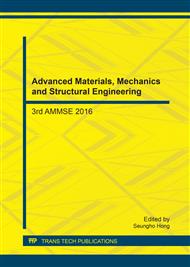p.175
p.183
p.189
p.195
p.201
p.208
p.214
p.220
p.224
Design of a Novel Locomotion Mechanism of Power Transmission Line Inspection Robot
Abstract:
The working environment of the inspection robot is a high altitude flexible cable environment. The robot navigating process must be stable and reliable. The robot mechanism grips the line though locomotion mechanism when navigating obstacles. The locomotion mechanism needs to have a strong clamping capacity and stability. According to the environmental characteristics of transmission lines, a novel locomotion mechanism of inspection robot is presented. The locomotion mechanism adopting differential mechanism can grip different diameter lines. The Tri-Step reducer design to ensure that the various model lines of rapid firmly clamped. The locomotion mechanism is introduced, and the gripper force is analyzed. The experiment results demonstrate that the mechanism has such characteristics as strong grip ability, good motion stability, and different diameter lines gripping capability.
Info:
Periodical:
Pages:
201-207
Citation:
Online since:
February 2017
Authors:
Price:
Сopyright:
© 2017 Trans Tech Publications Ltd. All Rights Reserved
Share:
Citation:


